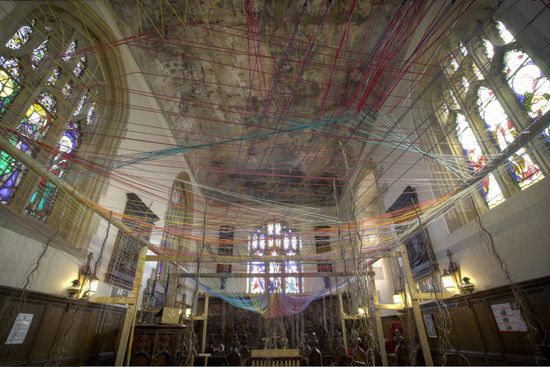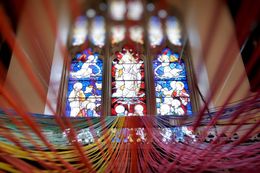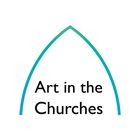
Art, Artists & Churches
Artists | Installations | ChurchesThis is a preview of the artists, their installation and their church
Artist Alexandra Carr
Installation Cloud of Unknowing
Venue Mickley Church

Cloud of Unknowing
The Cloud of Unknowing is a fog installation that plays with the boundary of materiality and immateriality. The concept of being 'courageous enough to surrender one's mind and ego to the realm of "unknowing"' is present in many forms of meditation, contemplation and prayer. The piece references a spiritual guide on contemplative prayer from the late Middle Ages. The use of light within the installation signifies an ephemeral and nebulous moment of awakening.
Much like faith, the piece has a sense of presence without definition of form, seeping into its environment. It is ever changing and elusive, much like our understanding of our place in the cosmos. As we approach comprehension, the edges dissolve away into the abstract nature and enormity of the concept, back to the 'naked blind feeling of being'.
Captivated by our quest to know the unknown, see the unseen and exist in the spaces in between, the installation presents a fleeting comprehensionof an unreachable place and a state of being, present but not properly understood.

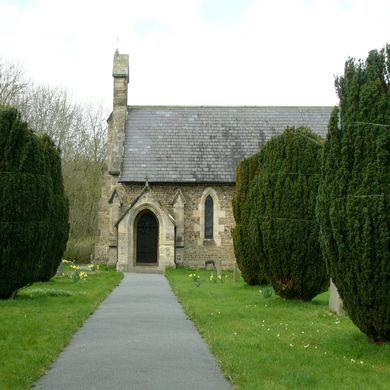
A small and simple church, the perfect location for a dramatic kinetic artwork
Artist Jonathan Gabb
Installation Wonder and War in Heaven
Venue Snape Castle Chapel

Wonder and War in Heaven
The name, ‘Wonder and War in Heaven’, is derived from the decayed ceiling fresco in the chapel, painted by Antonio Verrio (1636-1707). Verrio was reputedly responsible for introducing Baroque mural painting into England. (He is famous for his ceiling in Burghley House). The fresco is now a relic, partly due to damage caused when the chapel was used to store grain and rape seed in the late 18th century.
Gabb’s work draws out the spirit and drama of Verrio’s original fresco. The use of knotted cords, referencing vibrant colours understood to be contained within the original fresco, represent “the colours of heaven”. These cords are comprised into a canopy that creates a third ceiling in the space (the second ceiling made for Verrio’s fresco). The cords of colour are pulled apart in a web-like composition, incorporating portals from which the decayed fresco can be viewed.
Jon’s work reaches out to the past, to connect with the contemporary viewer, and provides a link through time to this historic work. The original story, “Wonder and War in Heaven” was taken from Revelations 12.9, telling of the casting out of heaven of the dragon (Satan) and with both colour and form this story also comes to live in the piece.
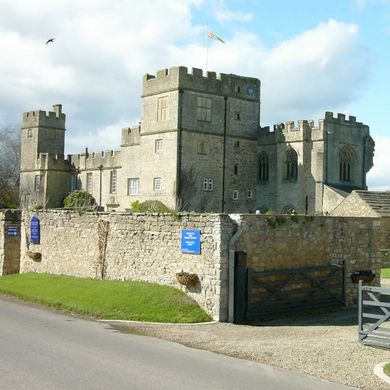
An ornate and intimate chapel nestles on the 1st floor of this little known historic castle
Artist Silvia Lerin
Installation Neons from Heaven
Venue Masham Church
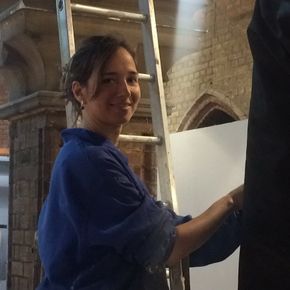
Neons from Heaven
Neons from Heaven is a poetic installation consisting of 100 large blue painted tubes, or ‘neons’.
The work is an artistic interpretation of the process we as humans go through at times when we need guidance in our lives. When we reach out to find a light to look into ourselves, to see the source of troubles, so we can face difficulties and challenges with new strength. ‘Neons from Heaven’ represents that moment of encounter with ourselves.
The light is represented by the blue tubes or ‘neons’, with blue being a heavenly colour, the colour of the sky, the sea and most importantly what we see on the horizon when the two join. As you walk underneath, there is a ‘stop moment’. You look up and see yourself reflected back by mirrors in the base of the tubes, representing the fact that the guidance you need could be actually deep within yourself.
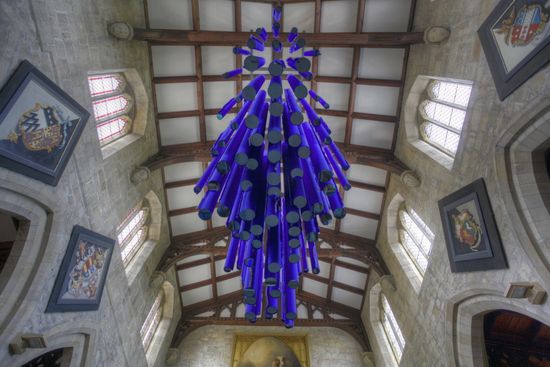
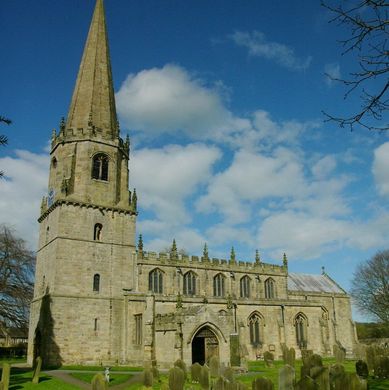
Masham Church is ancient, large and airy. It is the hub of the event.
Artist Ana Rosa Hopkins
Installation Le Bon Tempts Viendra
Venue Healey Church
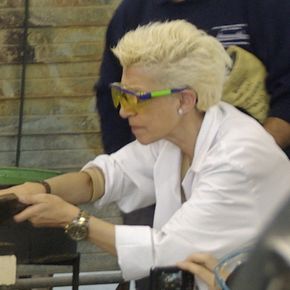
Le Bon Temps Viendra
The title of the work ‘Le Bon Temps Viendra’ (The good times will come) is the motto of the Harcourt family, who funded the building of Healey church. It appears in the west window.
The installation incorporates six cocoons suspended in the tall lantern tower of the church. They have been formed from raw materials; woven metal mesh, copper, bronze, brass, steel, glass, silk cocoons, acacia gum arabic, gold leaf and other materials.
The cocoons reflect on the potential of all human beings to change, to undergo a transformation, a metamorphosis. The outer shell is just our appearance, a facade, a cage but each has an inner core –from where any change must start. Resting on the walls of the tower and nave are butterflies representing our enlightenment, hope and belief, as well as our fragility.
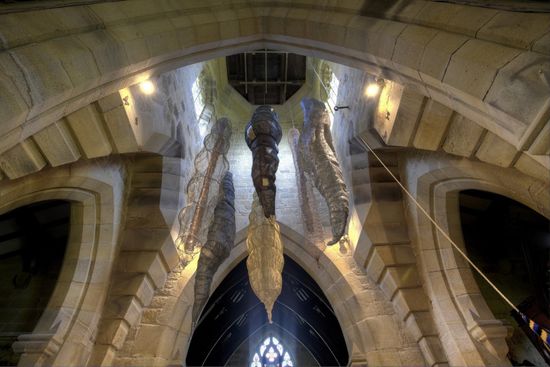
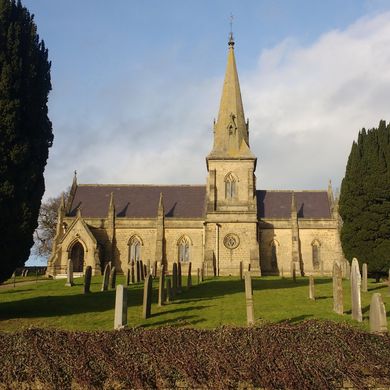
Healey Church has a vernacular intimacy, with huge views across the Burn Valley opposite
Artist Sarah Williams
Installation Every Small Difference
Venue North Stainley Church
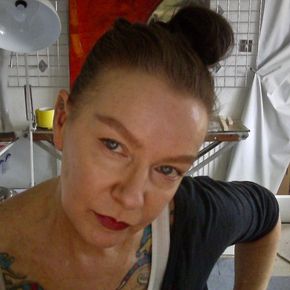
Every Small Difference
‘Every Small Difference’ is about the vulnerability of the planet to climate change, our responsibility to protect it and our vulnerability, if we fail to do so. It is also about how people have found sanctuary in the church in times of crisis, such as war and poverty, and how we will be seeking that sanctuary again if we do not rise to our collective responsibilities to protect the world.
The church is represented in the painting by the use of the triptych, the twelve bubbles depict the apostles and mirrored spheres attached to the canvas reflect the church back at the viewer. As we view, we reflect on our own place in the world and spirituality and consider, as individuals, how we can make a small difference.
The bubbles are so frail and vulnerable. They can be popped at any time, representing the delicacy of the planet and the fragilty of our own lives. How easily our own small, personal worlds can collapse, just like the planet, if we do not recognise and take positive action to do small things differently.

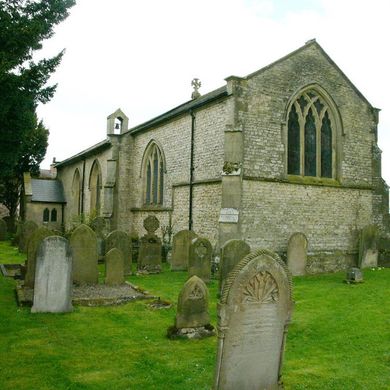
North Stainley Church is a quiet oasis next to the school house, and is a good location to start at
Artist Harriet Hill
Installation Rock of Ages
Venue Well Church
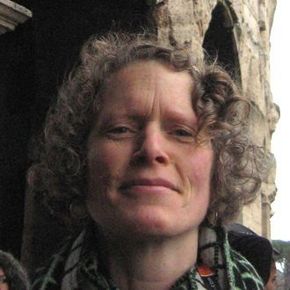
Rock of Ages
Rock of Ages takes the form of a huge suspended rock, nearly three metres long, created from woven willow and felt made from the wool of the local Masham sheep. Straw, baler twine and bale netting are felted into the surface. It is suspended from shock cord which stretches up to the far corners of the church roof. The title “Rock of Ages” is taken from the hymn by Augustus Toplady written in 1763.
This giant, fabricated rock represents the layering of the history of Well church and the community that has built it up over centuries. The use of local wool and familiar farm materials refers to the ordinary people who have lived and worked the land around the church and played a crucial part in its thousand-year history. The taught suspension cords reaching high across the church interior draw our attention to the architecture and space within the building
and make reference to its function as a place for spiritual worship. These strong red lines suggest a link from the present to our ancestors who came into and used the church, just as we do today.
Floating just above the floor, Rock of Ages is a strange, futuristic apparition, perhaps giving us a cue to consider our future in this world as well as reflect on the past.
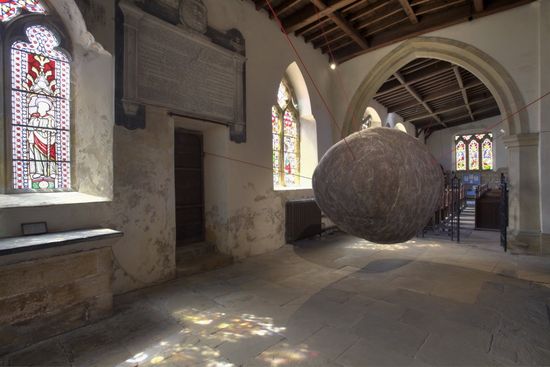
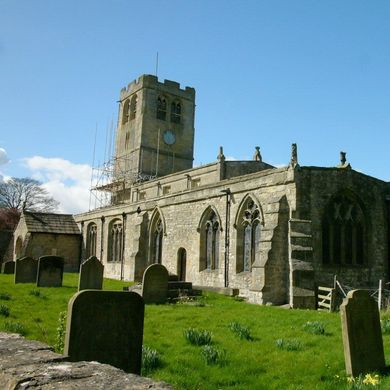
Well Church is steeped in history. It has a Roman mosaic and the tomb of Sir John Neville, died 1543
Artist Eduardo Niebla
Installation The Seven Colours
Venue West Tanfield Church
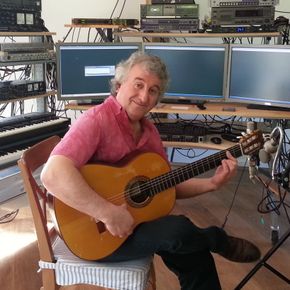
The Seven Colours
- Sound Installation
‘The Seven Colours’ is a composition about community, combining the sounds of the microcosm of West Tanfield’s community with those of the global community. The sentiment being that mankind should celebrate all communities with their different colours across all seven continents.
Eduardo has crafted a ‘sound palette’ which takes you on a journey through a thought-provoking collage of specially made recordings as well as the journey around the world connecting us all.
At the beginning of the piece you hear a train. A railway used to go through West Tanfield, supporting local agriculture and industry and taking young soldiers to war. The running water is the River Ure which runs through the village and is symbolic of connections. The religious chants are from all corners of the world, connecting global to local.
There are many other local recordings included (the children playing at the village primary school, the church bells and choir, the blacksmith and the village donkey!). It represents the diversity of lives, past and present, local and global, in this picturesque and industrious small Yorkshire village.
The final composition is an experience of sound. It is meditative, absorbing and enlightening.

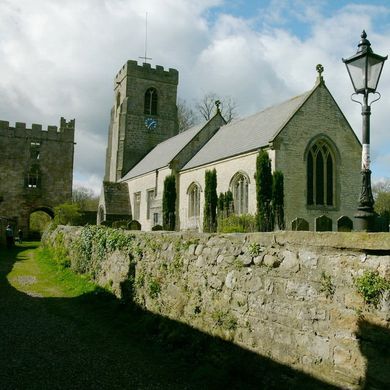
West Tanfield is a beautiful church in a beautiful location. It is ready to surprise with a sound installation
Artist Statements and Biographies
ALEXANDRA CARR
Statement
Raising questions about the nature of reality and our place in the cosmos, Carr invites the viewer on a journey of awakening and enlightenment. Captivated by our quest to know the unknown, see the unseen and exist in the spaces in between, Carr presents a fleeting comprehension of an unreachable place and state of being, present but not properly understood.
At first glance, Carr’s aesthetic is elegant and sedate. On closer inspection, a subtle order and mechanism becomes apparent. Carr generates a slow drawing in of the audience, not to view an image, or a moment, but to observe change over time. A single, transforming, crucial moment of change highlights the threshold of order to chaos where both states may exist at once. The boundaries of liminal spaces stress the notions of duality, opposites, contradiction, interplay and connectivity.
The point of observation is the focus of Carr’s work. Motion and parallax are employed to create illusion, highlighting how visual perception informs our experience of reality.
Through a manipulation of natural phenomena as media and by challenging our perception of our environment, Carr provokes change in the object and the viewer’s perspective in order to open a window into a world unknown.
Biography
Carr is an international, scientific, experimental artist working on a wide range of interdisciplinary projects in partnership with MIT, Oxford University and Durham Universities. The work makes responses to a range of patterns in nature, to natural processes and phenomena, from magnetism, ice structures, light and dark matter. Her practice involves collaboration with experts and world leading researchers including engineers, chemists, geologists, cosmologists and theoretical physicists. The works produced are experimental in nature and include drawing, sculpture, kinetic works, photography and video. Of particular focus is the boundary between art, science and technology.
Studying at Central Saint Martins and Camberwell College of Art she has gone on to exhibit work at the Fondation Cartier in Paris, in collaboration with Jean-Paul Gaultier, commissioned work from seminal musicians Radiohead, and was shortlisted for the Arts@CERN COLLIDE International Award 2016 and longlisted for the Aesthetica Art Prize 2017 and 2018.
She frequently exhibits and works internationally including the Verket Museum, Sweden and project spaces in Iceland. She spent six months at the artists’ collective HEIMA, in Seyðisfjörður, Iceland, as an artist in residence and mentor.
Carr was awarded a Leverhulme funded residency in Durham 2017 entitled ‘Sculpting with Light’, investigating medieval and modern cosmology in collaboration with physicists, historians and cosmologists. She has presented papers at Oxford, Durham, Universities and MIT as well as taking part in panel discussions.
Forthcoming collaborations include a project with a physicist and digital glass artist exploring a new hybrid language to visualise mathematics, and a project based at Oxford University exploring metamers, light spectra and materials development, a project based in Lund, Sweden with a geologist and a project with a performance and video artist exploring the drawn line and coordinate systems. She is currently Artist in Residence at the Josephine Butler College, Durham University, working in collaboration with Lee MacKenzie, the Writer in Residence, working on themes of environment and place in connection with the elements and cosmology.
Current artworks in progress include drawing (machines), kinetic and interactive sculptures concerning phase changes, smart materials and new technologies.
JONATHAN GABB
Statement
Jon Gabb works with both rudimentary and fine art materials, with a resolution to meld painting, sculpture, and the built environment; articulating colour, expressing weight, often producing random outcomes as a part of this process the work will inhabit a space and allow its architecture to form its outcome.
Biography
Jonathan Gabb, a London based artist, graduated from London Metropolitan University with a 1st class honours in Fine Art in 2008. His ambitious site specific installations have been recipients of a number of highly-coveted and competitive awards, including the WW SOLO Award in 2012, and the 2014 Saatchi Art Colour Showdown Competition – the most highly submitted online art prize in the world. Following his first successful solo exhibition “SYSTEM” at the WW Gallery in January 2013, Jonathan’s second solo show “Opera Rose” at Abrooks Art Gallery, was met with critical acclaim and listed in the top 5 shows to visit in Whitechapel Gallery’s First Thursdays. Jonathan has also had works exhibited at the Griffin Gallery, and at the Affordable Art Fair. He was nominated by Axisweb in 2013 as one of ten contemporary artists to watch and invest in, confirming his status as one of the UK’s most exciting emerging artists. More recently his work black + multiple 24 was selected by Alison Wilding for APT’s Creekside Open 2017 and his work tempo process + grass was exhibited at Lewisham Art House in 2017.
SILVIA LERIN
Statement
Her current artistic process is based on chance and aims to create unexpected compositions. Silvia provokes chance by painting with water that creates effects on surfaces like canvas, paper, etc… and that will determine the final composition; But lately she leaves the inspiring chance to happen, creating new shapes and compositions from a found object (e.g. a piece of wood, packaging protecting cardboard, a piece of metal) or even from situations or places of her current life, for example her first significant hurdle to overcome, when she arrived to London, was the London Underground and that contributed to her series ‘Mind the Gap’, the shapes, colours, volumes and even litter that she encountered on her daily journeys around the capital inspired her profoundly. Afterwards came the project ‘Inspired by an English garden’, it was very different to ‘Mind the Gap’, nevertheless still holds firmly to the style she has developed since coming to the city. The contrast from the underground (‘Mind the gap’) to the overground (English garden) was so vivid - the nature, vibrancy of colours, richness of combinations. As Silvia says her art is evolving as a diary would do, the series the chapters, the art pieces its pages…
Biography
Silvia Lerin is a visual artist living and working in London. She graduated with a BA (Hons) in Fine Art from the Polytechnic University of Valencia (Spain) in 1998. Since qualifying she has received numerous awards and grants, the most outstanding of which was the Pollock-Krasner Foundation Grant of New York in 2013, which enabled her to come to London, where she decided to stay and more recently has been awarded with The Annex Collection Award, UK. Her work is permanently exhibited in many museums in Spain, as well as numerous artworks which can be seen in various public buildings and private collections throughout Spain and abroad. Her work can also be viewed at www.silvialerin.com.
Her work encompasses painting, installations, sculpture and printing. Moving between painting and sculpture, material and medium, Lerin negotiates the tensions inherent in creating objects and installations that can be observed both as sculptural or spatial paintings and sculptures with a strong pictorial presence.
Silvia’s current artistic practice includes collections of different materials with painted canvas, based on discovering new ways of merging these materials with their surrounded space, as it happens in her installations or in some site specific works. Lately she has been inspired by encounters with objects found randomly (e.g. a piece of wood, or protective cardboard, or a metal device) to create shapes and compositions that reflect situations or places in her day to day life.
ANA ROSA HOPKINS
Statement
For over 20 years Ana Rosa Hopkins has collected and experimented with ‘Dead Objects’. These include common everyday objects and ones which have been abandoned, forgotten, derelict or partially destroyed which she uses in combination with her signature material, glass. She explores the symbolic and metaphorical dimensions of materials and objects and the histories and narratives which surround them within a social-political context. Her inquisitive practice is one of improvisation often leading to unexpected and unpredictable results where process and materials become more important that the object itself.
Biography
Ana Rosa Hopkins, born in Argentina to Italian and Spanish parents, is a British visual artist and sculptor based in Manchester. She holds a PhD by Practice entitled ‘Back-story in contemporary sculptural practice: from materials to inclusion’ from Manchester School of Art, Manchester Metropolitan University. She is a member of the Royal Society of Sculptors and the Contemporary Glass Society and has maintained a studio at the Rogue Artists’ Studios, Manchester since 2008.
Hopkins brings together her international career and experience with a record of ambitions exhibitions, residencies and projects. Her recent work includes: UK and international exhibitions in China, Africa, Spain, Portugal, Germany, Austria, Netherlands, Finland and Brazil; invited residencies at Village des Arts de Dakar, Senegal, (2017), The Royal Glass Factory, La Granja, Spain (2015-2016), International Guests Artist Residency at Plataforma Revolver, Lisbon, (2015), Ebenböckhaus, Munich (2013), and 21st Century Rural Museum, Porto and Lisbon (residency, commission and touring exhibition, 2012).
Her work has been acquired for private and institutional collections including the Harris Museum and Art Gallery, with the support of the Contemporary Arts Society, and the Royal Glass Factory Museum, Spain. She won the neo:artprize England (2012), was selected for the British Glass Biennale (2015), and was awarded a NADFAS North West Artists Bursary (2010). Hopkins was invited as a visiting lecturer, curator and workshop leader at University of Tianjin, Academy of Fine Art, Tianjin, China (2015-2018).Currently she is working on her post doctorate and parallel projects in Fez Medina Morocco, Senegal and Poland. She continues her international collaborations, talks and written contributions to artists’ exhibition catalogues.
SARAH WILLIAMS
Statement
Sarah has recently returned to painting full-time and having used a multitude of mediums in her creative work now confesses she is an oil paint addict. It is “the smell, the texture, the depth and colour of pigments, total nectar”. Her paintings are diary based. The colours, textures, shapes and marks communicating a visual world full of different emotions. As she paints she is learning about herself and trying to understand the world we live in, trapping it in time, bare and honest, trying to shed all the brainwashing process that has been bombarding us from before birth.
Biography
Sarah graduated from Norwich School of Art and Design in 1984 with a first class BA Hons. in Fine Art Painting, and having won the Stowell's Trophy went on to study MA Painting at the Royal Academy. She comes from a family of creative talent. Her father, Reg Williams, was a famous painter and member of the York Four. Her life as a creator and innovative artist was set out early, starting at 8 years old, with her first public art exhibition. During the three years at Norwich Art School she exhibited regularly in the art school gallery and Norwich Castle and visited Switzerland, exhibiting and working with Kurt Rupe. More recently, she has exhibited in galleries around England and has had her own businesses in Interior Design, Architectural Design, Furniture Design and Jewellery.
HARRIET HILL
Statement
Harriet Hills's installation work responds to the specifics of each new place. Opportunities to work with unknown and varied environments are essential for experimentation and the progression of her ideas. She plays with the dynamics between space, material and form, creating work that invites the viewer to engage actively.
"Having lived half my life in a rural community I am excited about the challenge of making art in this context; to address the significance of the church both as an architectural structure and as a sociopolitical centre point, historically and today."
Biography
Born in London in 1966, Harriet spent half her childhood in rural mid Wales sewing and making things. After completing a BA (Hons) Fine Art in Cardiff 1987 and learning Pattern Cutting in Liverpool she spent time making clothes, running away with the circus Archaos, and designing and making for theatre and interiors. Returning to Wales in 1995 she established a successful practice as a contemporary felt-maker, producing functional interior pieces, wall hangings and sculpture. She has taught felt-making extensively including a trip to Kazakhstan with the British Council in 2006.
In 2007 Harriet graduated with a distinction in MFA Textiles at Goldsmiths College and focused her practice on sculpture and installation. Based in South East London she has exhibited widely across the UK. Harriet continues to develop her art practice supported by work as a freelance prop-maker and art fabricator working for some of the UK’s leading artists.
The tactile quality of materials drives Harriet’s creativity and an understanding of how a space, material or structure can affect us. Using drawing as a physical medium and the dynamic of space itself, she employs ambiguity, scale and a sense of play to set up installations that provoke enquiry. Recently she has been experimenting with performative sculpture, making moving word installations as public art, out and about in her local community. Her short film “P.E.C.K.H.A.M.” was recently shown at TATE Exchange in London.
EDUARDO NIEBLA
Statement
For Eduardo Niebla, as a composer, music is the ultimate tool for sculpting feelings and thoughts in any imaginary landscape, real or unreal.
Through his life he has been developing himself to find the sounds that more and more accurately express what his feelings and thoughts want to portray. He has been very strongly influenced by traditions - in his case Spanish gypsy flamenco, gypsy jazz, classical music, modern and experimental music, and "for a long time I have felt that art is a universal language with no barriers to humanity".
Biography
In a career spanning four decades the composer and guitarist Eduardo Niebla has been acclaimed as one of the most potent forces in flamenco jazz fusion. His concert appearances have included the Jaipur Festival India, the Queen Elizabeth Hall London, the Tbilisi International Jazz Festival, the Olympic Games Greece and Glastonbury, as well as extensive concert tours to Europe, the Baltic States, the Middle East and South Africa.
He has collaborated with some of the top musicians in jazz, world roots and pop including saxophonist Lol Coxhill, Indian maestros Nishat & Wajahat Khan, Deepak Ram (flute) Kala Ramnath (violin), Purbayan Chatterjee (sitar), Palestinian oud player Adel Salameh, trance phenomenon Juno Reactor, the Dante String Quartet and pop musicians George Michael and Craig David. He has composed music for films and documentaries, including for the BBC, as well as large scale commissions for festivals, and has released 24 albums of his original compositions:
“His latest album demonstrates his fluid, technically brilliant guitar work… exquisite.” (THE GUARDIAN)
"A formidable guitarist and a beautifully sequenced disc by a musically fluent master of today's generation…hugely enjoyable, experimental, with many stunning moments. Unbelievably invigorating." (SONGLINES)
Eduardo was born in Morocco in 1955 to Andalucian parents, the 7th of 11 children. In 1960 they became refugees and settled in Cataluña Spain where Eduardo grew up. He taught himself the guitar and at 18 formed the cult symphonic rock band “Atila”. He was rated alongside Paco de Lucia as one of the top guitarists in the Hispanic Peninsula and in 1975 he moved to Paris where he took part in exhibitions of conceptual art with the painter Jaume Xifra. In 1978 he moved to London and in 2001 North Yorkshire and is widely regarded as one of the outstanding guitarists of his generation.
